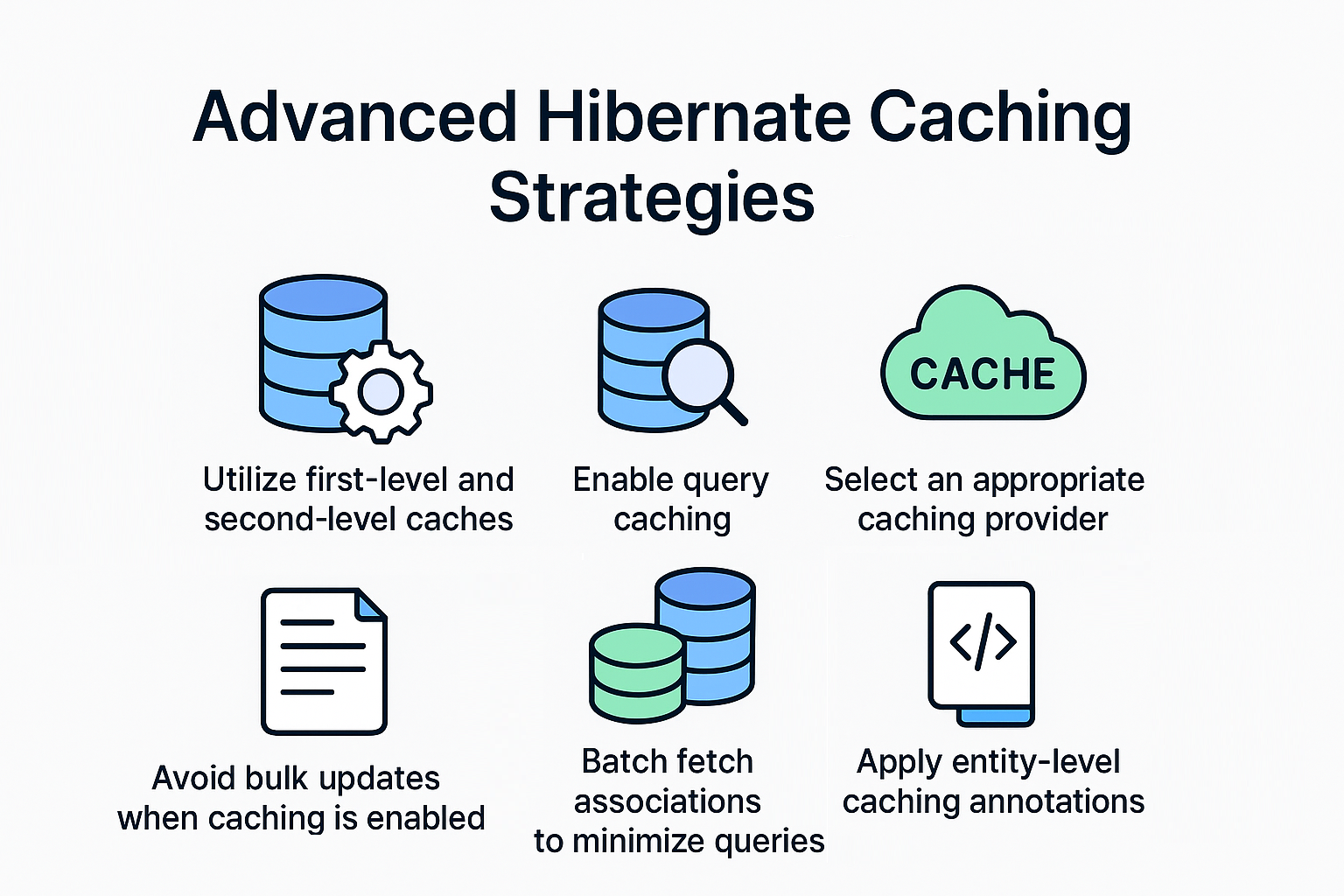In enterprise applications, performance and scalability are critical. Every database query adds latency and increases server load. Hibernate, as a leading ORM framework, provides powerful caching mechanisms that minimize database hits by storing frequently accessed data in memory.
This tutorial dives deep into advanced Hibernate caching strategies, explaining how to use first-level cache, second-level cache, and query cache effectively, while avoiding common pitfalls. By the end, you’ll know how to design production-ready caching solutions for Hibernate applications.
Why Caching Matters in Hibernate
- Reduced Latency: Avoids repetitive trips to the database.
- Improved Scalability: Reduces database load under heavy traffic.
- Cost Efficiency: Saves hardware and infrastructure costs by optimizing queries.
Analogy: Caching in Hibernate is like reusing answers you already know instead of re-asking the same question.
Hibernate Cache Levels
1. First-Level Cache (Session Cache)
- Scope: Per Hibernate
Session. - Enabled by default.
- Guarantees identity (same object instance returned within a session).
Session session = sessionFactory.openSession();
Employee emp1 = session.get(Employee.class, 1L);
Employee emp2 = session.get(Employee.class, 1L);
// emp1 == emp2 (same instance, cached in first-level cache)
✅ Best Practice: Use session per request to leverage first-level caching effectively.
2. Second-Level Cache (SessionFactory Cache)
- Scope: Shared across sessions for the same
SessionFactory. - Requires configuration and cache provider.
- Stores entities, collections, and query results.
spring.jpa.properties.hibernate.cache.use_second_level_cache=true
spring.jpa.properties.hibernate.cache.region.factory_class=org.hibernate.cache.jcache.JCacheRegionFactory
spring.jpa.properties.javax.cache.provider=org.ehcache.jsr107.EhcacheCachingProvider
Entity Example:
@Cacheable
@Entity
public class Employee {
@Id
private Long id;
private String name;
}
✅ Best Practice: Use second-level cache for reference data (e.g., countries, roles). Avoid caching frequently updated entities.
3. Query Cache
- Stores query result sets (IDs, not entities).
- Requires second-level cache to be enabled.
spring.jpa.properties.hibernate.cache.use_query_cache=true
Query query = session.createQuery("FROM Employee WHERE department = :dept");
query.setParameter("dept", "Engineering");
query.setCacheable(true);
List<Employee> employees = query.list();
✅ Best Practice: Use for read-mostly queries with limited dynamic parameters.
Caching Providers
Hibernate supports multiple caching providers:
- Ehcache (most popular, simple, JVM-based).
- Infinispan (distributed, scalable).
- Hazelcast (cloud-native, distributed).
- Redis (external, fast key-value store).
Ehcache Example Configuration:
<ehcache>
<cache name="com.example.Employee"
maxEntriesLocalHeap="1000"
timeToLiveSeconds="300"
eternal="false"
statistics="true"/>
</ehcache>
CRUD Operations with Cache
Save / Update
- Cache is updated automatically after entity changes.
- Beware of cache invalidation when using bulk updates.
Delete
- Removes entity from cache as well as database.
session.beginTransaction();
Employee emp = session.get(Employee.class, 1L);
session.delete(emp);
session.getTransaction().commit();
✅ Best Practice: Avoid bulk HQL/SQL updates when caching is enabled, as they bypass cache synchronization.
Performance Optimization Techniques
-
Batch Fetching:
spring.jpa.properties.hibernate.default_batch_fetch_size=20 -
Use DTO Projections: Fetch only required fields.
-
Lazy Loading: Load associations only when needed (ordering food only when you need it).
-
Cache Regions: Separate cache regions for different entities.
@Cacheable
@org.hibernate.annotations.Cache(
usage = CacheConcurrencyStrategy.READ_WRITE,
region = "EmployeeCache"
)
@Entity
public class Employee { ... }
Real-World Spring Boot Integration
@Repository
public interface EmployeeRepository extends JpaRepository<Employee, Long> {
@Cacheable("employeeCache")
List<Employee> findByDepartment(String department);
}
Spring Boot integrates seamlessly with Hibernate caching and Spring Cache abstraction.
Common Pitfalls
- Caching entities that change frequently → leads to stale data.
- Forgetting to configure eviction policies → cache bloating.
- Using query cache for dynamic queries → low hit ratio.
- Ignoring transaction isolation levels → inconsistent cached data.
Best Practices for Production
- Cache reference data, not transactional data.
- Use READ_ONLY or NONSTRICT_READ_WRITE strategy for static data.
- Monitor cache hit/miss ratios with metrics.
- Use distributed caches for microservices (Infinispan, Redis).
- Invalidate or refresh caches on updates.
📌 Hibernate Version Notes
Hibernate 5.x
- Relies on
javax.persistence. - Second-level cache providers: Ehcache, Infinispan, etc.
- Legacy SessionFactory setup still common.
Hibernate 6.x
- Migrated to Jakarta Persistence (
jakarta.persistence). - Improved cache integration with modern providers.
- Better query cache handling with enhanced SQL support.
Conclusion and Key Takeaways
Hibernate caching is a powerful tool for performance optimization. By leveraging first-level, second-level, and query caching wisely, developers can drastically reduce database load and improve scalability.
Key Takeaway: Cache read-mostly, stable data, monitor performance, and choose the right provider and strategy for your application’s workload.
FAQ: Expert-Level Questions
1. What’s the difference between Hibernate and JPA?
JPA is a specification, Hibernate is an implementation with extra features.
2. How does Hibernate caching improve performance?
By reducing repeated database hits via memory storage at session and factory levels.
3. What are the drawbacks of eager fetching?
It loads all associations at once, which can slow down performance.
4. How do I solve the N+1 select problem in Hibernate?
Use JOIN FETCH, batch fetching, or entity graphs.
5. Can I use Hibernate without Spring?
Yes, Hibernate works standalone, but Spring Boot simplifies caching and configuration.
6. What’s the best strategy for inheritance mapping?
Depends on needs: SINGLE_TABLE for performance, JOINED for normalized data.
7. How does Hibernate handle composite keys?
With @EmbeddedId or @IdClass annotations.
8. How is Hibernate 6 different from Hibernate 5?
Hibernate 6 uses Jakarta Persistence, improved query APIs, and modern cache integrations.
9. Is Hibernate suitable for microservices?
Yes, but use distributed caching and keep cache regions isolated.
10. When should I not use Hibernate caching?
Avoid caching for highly volatile, frequently updated data.
